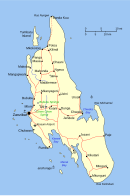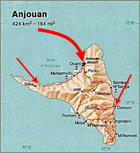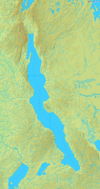Portal:Tanzania/Featured article
| This page is currently inactive and is retained for historical reference. Either the page is no longer relevant or consensus on its purpose has become unclear. To revive discussion, seek broader input via a forum such as the village pump. |
Archive
[edit]Featured article/1
[edit]Dar es Salaam (Arabic: دار السلام [translation: "Abode of Peace"] Dār as-Salām, cf. "Yer u-salem"), formerly Mzizima, is the largest city in Tanzania. With a population estimated around 2,500,000, it is also the country's richest city and a regionally important economic centre. Though Dar es Salaam lost its official status as capital city to Dodoma in 1996, it remains the centre of the permanent central government bureaucracy and continues to serve as the capital for the Dar es Salaam Region.
Featured article/2
[edit]Zanzibar /ˈzænzɪbɑːr/ is the name for an archipelago in the Indian Ocean 25–50 km off the coast of East Africa, which is part of Tanzania. The archipelago consists of numerous small islands and two large ones: Unguja (the main island, sometimes informally referred to as 'Zanzibar'), and Pemba Island. The archipelago was once the separate state of Zanzibar, which united with Tanganyika to form Tanzania (derived from the two names), and still enjoys a high degree of autonomy within the union. The capital of Zanzibar, located on the island of Unguja, is Zanzibar City. The city's old quarter, known as Stone Town, is a World Heritage Site.
Zanzibar's main industries are spices (which include cloves, nutmeg, cinnamon and pepper), raffia, and tourism. Zanzibar is also the home of the endemic Zanzibar Red Colobus and the elusive Zanzibar Leopard. The word "Zanzibar" probably derives from the Persian زنگبار, Zangi-bar ("coast of the blacks") and it is also known as Zanji-bar in Arabic. "Zanzibar" may also refer to the spice ginger (genus Zingiber). Pemba Island is the only island apart from Zanzibar that still produces cloves on a major basis which is the primary source of spice income for the islands.
Featured article/3
[edit]Swahili (also called Kiswahili) is a Bantu language. It is the most widely spoken language of sub-Saharan Africa. Although only 5-10 million people speak it as their native language, Swahili is somewhat of a Southeast African lingua franca, being spoken by around 80 million speakers.
Swahili is the mother tongue of the Swahili people (or Waswahili) who inhabit several large stretches of the Indian Ocean coastlines from southern Somalia as far south as Mozambique's border region with Tanzania. Swahili has become a lingua franca in much of East Africa and the Democratic Republic of the Congo, and is now the only African language among the official working languages of the African Union. Swahili is also taught in the major universities in the world, and several international media outlets, such as the BBC, Voice of America and Xinhua have Swahili programs.
Featured article/4
[edit]The Swahili are a people and culture found on the coast of East Africa, mainly the coastal regions and the islands of Kenya and Tanzania, and north Mozambique. According to JoshuaProject, the Swahili number in at around 1,328,000. The name Swahili is derived from the Arabic word Sawahil, meaning "coastal dwellers", and they speak the Swahili language. They also speak the official languages of their respective countries: English in Tanzania and Kenya, Portuguese in Mozambique and Somali in Somalia, and French in Comoros. Note that only a small fraction of those who use Swahili are first language speakers and even fewer are ethnic Swahilis.
Featured article/5
[edit]Kilimanjaro with its three volcanic cones, Kibo, Mawenzi, and Shira, is an inactive stratovolcano in north-eastern Tanzania. Although it does not have the highest elevation, Kilimanjaro is the tallest free-standing mountain rise in the world, rising 4,600 m (15,100 ft) from its base, and includes the highest peak in Africa at 5,895 meters (19,340 ft), providing a dramatic view from the surrounding plains. Kilimanjaro is a Maasai word meaning Large Rock.
Featured article/6
[edit]Lake Victoria or Victoria Nyanza (also known as Ukerewe, Nalubaale, Sango, or Lolwe) is one of the African Great Lakes. The lake was named after the United Kingdom's Queen Victoria, by John Hanning Speke, the first European to see the lake.
At 68,800 square kilometres (26,600 sq mi), Lake Victoria is Africa’s largest lake, and the largest tropical lake in the world. As Lake Michigan-Huron is connected at the same elevation pool and is thus treated as one lake by hydrologists and geographers, Lake Victoria is the world’s third-largest freshwater lake. In terms of volume, it is the world’s seventh-largest freshwater lake, containing 2,750 cubic kilometres (2.23×109 acre⋅ft) of water.
The lake receives most of its water from direct precipitation. Its largest influent is the Kagera River, the mouth of which lies on the lake's western shore. The only river to leave the lake, the White Nile leaves at Jinja, Uganda, on the lake’s north shore. It occupies a shallow depression in the East African Plateau, and has a maximum depth of 84 metres (276 ft) and an average depth of 20 metres (66 ft). Its catchment area covers 184,000 square kilometres (71,040 mi2).
Featured article/7
[edit]The Anglo-Zanzibar War was fought between the United Kingdom and Zanzibar on 27 August 1896. The conflict lasted approximately 38 minutes and is the shortest war in history. The immediate cause of the war was the death of the pro-British Sultan Hamad bin Thuwaini on 25 August 1896 and the subsequent succession of Sultan Khalid bin Barghash. The British authorities preferred Hamud bin Muhammed as Sultan. In accordance with a treaty signed in 1886, a condition for accession to the sultanate was that the candidate obtain the permission of the British Consul, and Khalid had not fulfilled this requirement. The British considered this a casus belli and sent an ultimatum to Khalid demanding that he order his forces to stand down and leave the palace. In response, Khalid called up his palace guard and barricaded himself inside the palace.
The ultimatum expired at 09:00 East Africa Time (EAT) on 27 August, by which time the British had gathered three cruisers, two gunships, 150 marines and sailors, and 900 Zanzibaris in the harbour area. The Royal Navy contingent were under the command of Rear-Admiral Harry Rawson whilst their Zanzibaris were commanded by Brigadier-General Lloyd Mathews of the Zanzibar army.
Featured article/8
[edit]The Zanzibar Revolution saw the 1964 overthrow of the Sultan of Zanzibar and his mainly Arab government by local African revolutionaries. An ethnically diverse state consisting of a number of islands off the east coast of Tanganyika, Zanzibar had been granted independence by Britain in 1963. However, a series of parliamentary elections resulted in the Arab minority retaining the hold on power it had inherited from Zanzibar's former existence as an overseas territory of Oman. Frustrated by under-representation in Parliament despite winning 54% of the vote in the July 1963 election, the mainly African Afro-Shirazi Party (ASP) allied itself with the left-wing Umma Party, and on 12 January 1964 ASP member John Okello mobilised around 600–800 revolutionaries on the main island of Unguja. Having overrun the country's police force and appropriated their weaponry, the insurgents proceeded to Zanzibar Town where they overthrew the Sultan and his government. Reprisals against Arab and South Asian civilians on the island followed; the resulting death toll is disputed, with estimates ranging from several hundred to 20,000. The moderate ASP leader Abeid Karume became the country's new president and head of state, and positions of power were granted to Umma party members.
Featured article/9
[edit]The invasion of Anjouan (code-named Operation Democracy in Comoros), on March 25, 2008, was an amphibious assault led by the Comoros, backed by African Union (AU) forces, including troops from Sudan, Tanzania, Senegal, along with logistical support from Libya and France. The objective of the invasion was to topple Colonel Mohamed Bacar's leadership in Anjouan, an island part of the Union of Comoros, when he refused to step down after a disputed 2007 election, in defiance of the federal government and the AU. The Comoros archipelago in the Indian Ocean has had a fractious history since independence from France, experiencing more than 20 coups or attempted coups.
The invasion occurred on the early morning of March 25, 2008. The main towns were quickly overrun and the island was declared under the control of the invading forces the same day. Mohamed Bacar managed to escape to Mayotte on March 26 and requested political asylum. He was subsequently held in custody there by the French administration and brought to the island of Réunion. On May 15, France rejected Bacar's request for asylum but the French refugee office ruled that the ousted leader could not be extradited to the Comoros because of the risk of persecution.
Featured article/10
[edit]The post of Sultan of Zanzibar was created on 19 October 1856, after the death of Sa'id ibn Sultan, who had ruled Oman and Zanzibar as the Sultan of Oman since 1804. The Sultans of Zanzibar were of a cadet branch of the Al Bu Sa'id Dynasty of Oman.
In 1698, Zanzibar became part of the overseas holdings of Oman, falling under the control of the Sultan of Oman. The Arabs established garrisons at Zanzibar, Pemba, and Kilwa. In 1832 or 1840, the date varies among sources, Sa'id ibn Sultan moved his capital from Muscat in Oman to Stone Town. He established a ruling Arab elite and encouraged the development of clove plantations, using the island's slave labour. Zanzibar's commerce fell increasingly into the hands of traders from the Indian subcontinent, whom Sa'id encouraged to settle on the island. After his death in 1856, two of his sons—Majid ibn Sa'id and Thuwaini ibn Sa'id—struggled over the succession. Zanzibar and Oman were divided into two separate principalities. Majid became the Sultan of Zanzibar, while Thuwaini became the Sultan of Oman. During his 14-year reign as sultan, Majid consolidated his power around the East African slave trade.
Featured article/11
[edit]The Battle for Lake Tanganyika was a series of naval engagements that took place between elements of the Royal Navy, Force Publique and the Kaiserliche Marine between December 1915 and February 1916, during the First World War. The intention was to secure control of the strategically important Lake Tanganyika, which had been dominated by German naval units since the beginning of the war. The British forces, consisting of two motor boats named HMS Mimi and HMS Toutou under the command of the eccentric Lieutenant-Commander Geoffrey Spicer-Simson were transported to South Africa and from there by railway, river and by being dragged through the African jungle, to the lake.
In two short engagements the small motor boats attacked and defeated two of their German opponents. In the first action, on 26 December 1915 the Kingani was damaged and captured, becoming HMS Fifi. In the second, the small flotilla overwhelmed and sank the Hedwig von Wissman. The Germans maintained a third large and heavily armed craft on the lake, the Graf von Götzen, this craft was attacked indecisively by Belgian aircraft and was later scuttled. Developments in the land-based conflict caused the Germans to withdraw from the lake.
Featured article/12
[edit]The Aga Khan University (AKU) is a coeducational research university spread over three continents. It was granted its charter in 1983 as Pakistan's first private, autonomous university. AKU was founded by His Highness the Aga Khan, and is part of the Aga Khan Development Network. AKU is an international University with 11 teaching sites spread over 8 countries - Afghanistan, Kenya, Pakistan, Tanzania, Uganda, Syria, Egypt and the United Kingdom. Its principal campus is located in the metropolitan city of Karachi, Pakistan with another major teaching hospital in Kenya. A 450-million dollar campus is also planned for Arusha, in north-eastern Tanzania to be built in the next 15 years. The Medical College of AKU is generally known as the "Harvard of the East".
According to the Higher Education Commission of Pakistan (HEC) ranking of Universities in Pakistan, The Aga Khan University ranked first in Health Sciences, with a cumulative rank score higher than any other university in Pakistan. The HEC also ranked the University number one overall in Pakistan based on the global impact of its research.
AKU's objective is to promote human welfare by disseminating knowledge and providing instruction, training, research and service in the health sciences, education, liberal arts, the sciences and such other branches of learning as the University may determine.
Featured article/13
[edit]In the 1998 United States embassy bombings (August 7, 1998) hundreds of people were killed in simultaneous truck bomb explosions at the United States embassies in the major East African cities of Dar es Salaam, Tanzania and Nairobi, Kenya. The attacks, linked to local members of the Egyptian Islamic Jihad brought Osama bin Laden and Ayman al-Zawahiri to American attention for the first time, and resulted in the U.S. Federal Bureau of Investigation placing bin Laden on its Ten Most Wanted list.
The bombings are widely believed to have been revenge for American involvement in the extradition, and alleged torture, of four members of Egyptian Islamic Jihad (EIJ) who had been arrested in Albania in the two months prior to the explosions and extradited to Egypt. Between June and July, Ahmad Isma'il 'Uthman Saleh, Ahmad Ibrahim al-Sayyid al-Naggar, Shawqi Salama Mustafa Atiya and Mohamed Hassan Tita were all renditioned from Albania to Egypt, with the cooperation of the United States, accused of participating in the assassination of Rifaat el-Mahgoub, as well as a later plot against the Khan el-Khalili market in Cairo. The following month, a communique was issued warning the US that a "response" was being prepared to repay them for their interference.
Featured article/14
[edit]The Great Lakes refugee crisis is the common name for the situation beginning with the exodus in April 1994 of over two million Rwandans to neighboring countries of the Great Lakes region of Africa in the aftermath of the Rwandan Genocide. Many of the refugees were Hutu ethnics fleeing the predominantly Tutsi Rwandese Patriotic Front (RPF), which invaded to end the Rwandan Genocide. However, the humanitarian relief effort was vastly complicated by the presence among the refugees of many of the Interahamwe and government officials who carried out the genocide, who used the refugee camps as bases to launch attacks against the new government led by Paul Kagame. The camps in Zaire became particularly politicized and militarized. The knowledge that humanitarian aid was being diverted to further the aims of the genocidaires led many humanitarian organizations to withdraw their assistance.
The conflict escalated until the start of the First Congo War in late 1996, when RPF-supported rebels invaded Zaire (soon thereafter, the Democratic Republic of the Congo) and the refugees were repatriated.
Featured article/15
[edit]Portal:Tanzania/Featured article/15
view -
talk -
history
Nominations
[edit]Articles featured here should be assessed at class B or above on the article talkpage. Please place candidates in the section below ("New nominations") for future selected articles, using the following template:
=== [[Your article here]] === Include a summary or the first paragraph of the article here. ---- Include your reasons for nominating the article here. ~~~~ <br clear="all">













